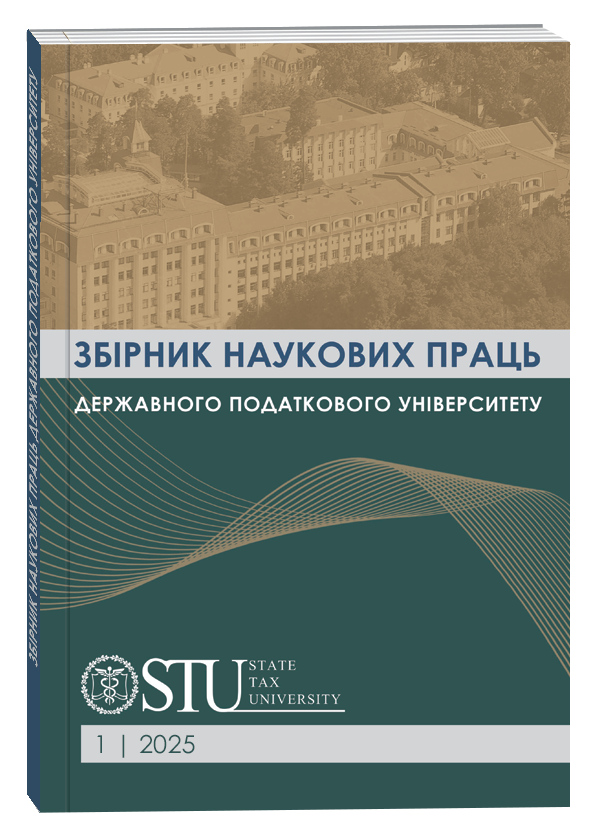RISKS WITHIN E-AUDIT AND WAYS TO MINIMIZE THEM
DOI:
https://doi.org/10.32782/2617-5940.1.2025.1Keywords:
e-audit, e-audit risks, audit consulting, artificial intelligence in audit, risk classification, digitalization of audit, tax control, risk diagnosticsAbstract
The purpose of the article is to identify the key risks that may arise in the process of implementing electronic audit, and also to formulate the areas of action to minimize their strength or probability of occurrence. The article uses general scientific and special scientific research methods. General scientific methods include deduction, analysis, classification, and others. Special scientific methods include risk mapping, risk scoring, rating, and others. The research methodology consists of working with sources at the first stage with the identification of risks that are characteristic of the electronic audit process when used for tax control purposes. The next step is to classify the existing risks, identify the most significant ones, and conduct a scoring assessment in terms of probability of occurrence, potential impact, and weight. Upon completion of the normalization of the weight of each risk, a rating is performed, and a risk signal map is built to visualize the results. As a result, conclusions are formulated regarding the prioritization of existing risks and threats in the process of implementation and use of electronic audit of the State Tax Service of Ukraine. The paper investigates the risks of electronic audit and ways to minimize them in the context of digitalization of control procedures. The main types of risks are systematized and classified according to various criteria: stages of e-audit, source of occurrence, type of technical problems, interaction with tax authorities, nature of violations detection, e-audit results, human factor impact and information security. The most significant risks have been identified, namely artificial intelligence hallucinations, hacker interference with the system, lack of programming specialists, overdependence on service providers, use of data for illegal purposes, and software incompatibility. The identified risks are assessed in terms of probability and potential impact. The author proposes a set of measures to minimize each of the identified risks aimed at improving the efficiency and security of electronic audit systems. The value of the study is manifested in both practical and theoretical aspects. The practical value lies in the fact that the results obtained allow prioritizing the work with risks when implementing electronic audit, as well as in the further improvement of the mechanism, to maximize the efficiency of the process and minimize the likelihood or severity of destructive phenomena. The theoretical value lies in the further development of the theory of e-audit risk management.
References
Безверхий К., Поддубна Н. Prerequisites for the implementation of e-audit in Ukraine. Scientia fructuosa. 2023. № 2. С. 92–104. DOI: https://doi.org/10.31617/1.2023(148)09
Гай О., Кононенко Л., Черновол О. Tax audit in the conditions of digitalization: current state, problems, perspectives. Економіка та суспільство. 2023. № 54. С. 54–62. DOI: https://doi.org/10.32782/2023-54-16
Назарова К., Безверхий К., Гордополов В., Мельник Т., Поддубна Н. Аналіз ризиків діяльності компаній на основі нефінансових і фінансових звітів. Agricultural and Resource Economics: International Scientific E-Journal. 2021. Вип. 7. № 4. С. 180–199. DOI: https://doi.org/10.51599/are.2021.07.04.10.
Топащенко А. А., Артюх О. В. Електронний фінансовий контроль: можливості та ризики. Стратегія розвитку України: фінансово-економічний та гуманітарний аспекти: матеріали X Міжнародної науково-практичної конференції. 2023. С. 344–346.
Al-Salmi M., Wee S., Akbar F. Impact of E-Audit on Public Organization’s Performance in Oman. 3rd Asia Pacific International Conference on Industrial Engineering and Operations Management. 2022. P. 4127–4135. DOI: https://doi.org/10.46254/AP03.20220681
Al-Taee S.H.H., Flayyih H.H. Impact of the electronic internal auditing based on IT governance to reduce auditing risk. Corporate Governance and Organizational Behavior Review. Vol. 7. № 1. 2023. P. 94–100. DOI: https://doi.org/10.22495/cgobrv7i1p9
Bezverkhyi K., Poddubna N. Audit in the digital economy. Foreign trade: economics, finance, law. Vol. 123. № 4. 2022. P. 81–90. DOI: https://doi.org/10.31617/3.2022(123)07
Chvertko L. Challenges of digital platforms implementation for cooperation of business and tax authorities. Economic Security in the Context of Systemic Transformations. International Conference. 2024. P. 127–130. DOI: https://doi.org/10.53486/escst2023.15
Hakim L., Pardomuan R., Tantri M. Electronic Audit (E-Audit), Audit Judgement, Corruption Detection And Audit Quality: BPK RI. IJHCM: International Journal Of Human Capital Management. 2023. Vol. 7. № 1. P. 1–27. DOI: https://doi.org/10.21009/IJHCM.07.01.1
Indriyanto E. The role of information technology in increasing audit process efficiency. Jurnal Ekonomi. Vol. 7. № 2. 2023. P. 1441–1446.
Susanto H., et al. The Influence of Independence, Experience, and Competence on Audit Quality Mediated by the Effectiveness of E-Audit. Research Horizon. Vol. 3. №1. 2023. P. 348–361.
Zakaria, Hesham. The use of artificial intelligence in e-accounting audit. The fourth industrial revolution: Implementation of artificial intelligence for growing business success. 2021. P. 341–356. DOI: https://doi.org/10.1007/978-3-030-62796-6_20
Bezverkhyi K., Poddubna N. (2023) Peredumovy vprovadzhennia elektronnoho audytu v Ukraini [Prerequisites for the implementation of e-audit in Ukraine]. Scientia fructuosa, no. 2, pp. 92–104. DOI: https://doi.org/10.31617/1.2023(148)09
Hai O., Kononenko L., Chernovol O. (2023) Podatkovyi audyt v umovakh didzhytalizatsii: suchasnyi stan, problemy, perspektyvy [Tax audit in the conditions of digitalization: current state, problems, perspectives]. Ekonomika ta suspilstvo – Economy and Society, no. 54, pp. 54–62. DOI: https://doi.org/10.32782/2023-54-16
Nazarova K., Bezverkhyi K., Hordopolov V., Melnyk T., Poddubna N. (2021) Analiz ryzykiv diialnosti kompanii na osnovi nefinansovykh i finansovykh zvitiv [Risk analysis of companies' activities on the basis of non-financial and financial statements]. Agricultural and Resource Economics: International Scientific E-Journal, vol. 7, no. 4, pp. 180–199. DOI: https://doi.org/10.51599/are.2021.07.04.10
Topashchenko A. A., Artiukh O. V. (2023) Elektronnyi finansovyi kontrol: mozhlyvosti ta ryzyky [Electronic financial control: opportunities and risks]. Stratehiia rozvytku Ukrainy: finansovo-ekonomichnyi ta humanitarnyi aspekty: materialy X Mizhnarodnoi naukovo-praktychnoi konferentsii – Ukraine's Development Strategy: Financial-Economic and Humanitarian Aspects: Proceedings of the X International Scientific-Practical Conference, pp. 344–346.
Al-Salmi M., Wee S., Akbar F. (2022) Impact of E-Audit on Public Organization's Performance in Oman. 3rd Asia Pacific International Conference on Industrial Engineering and Operations Management, pp. 4127–4135. DOI: https://doi.org/10.46254/AP03.20220681
Al-Taee S.H.H., Flayyih H.H. (2023) Impact of the electronic internal auditing based on IT governance to reduce auditing risk. Corporate Governance and Organizational Behavior Review, vol. 7, no. 1, pp. 94–100. DOI: https://doi.org/10.22495/cgobrv7i1p9
Bezverkhyi K., Poddubna N. (2022) Audit in the digital economy. Foreign trade: economics, finance, law, vol. 123, no. 4, pp. 81–90. DOI: https://doi.org/10.31617/3.2022(123)07
Chvertko L. (2024) Challenges of digital platforms implementation for cooperation of business and tax authorities. Economic Security in the Context of Systemic Transformations. International Conference, pp. 127–130. DOI: https://doi.org/10.53486/escst2023.15
Hakim L., Pardomuan R., Tantri M. (2023) Electronic Audit (E-Audit), Audit Judgement, Corruption Detection And Audit Quality: BPK RI. IJHCM: International Journal Of Human Capital Management, vol. 7, no. 1, pp. 1–27. DOI: https://doi.org/10.21009/IJHCM.07.01.1
Indriyanto E. (2023) The role of information technology in increasing audit process efficiency. Jurnal Ekonomi, vol. 7, no. 2, pp. 1441–1446.
Susanto H., et al. (2023) The Influence of Independence, Experience, and Competence on Audit Quality Mediated by the Effectiveness of E-Audit. Research Horizon, vol. 3, no. 1, pp. 348–361.
Zakaria H. (2021) The use of artificial intelligence in e-accounting audit. The fourth industrial revolution: Implementation of artificial intelligence for growing business success, pp. 341–356. DOI: https://doi.org/10.1007/978-3-030-62796-6_20



